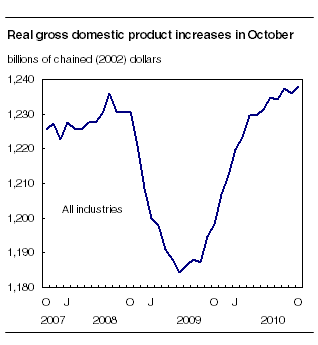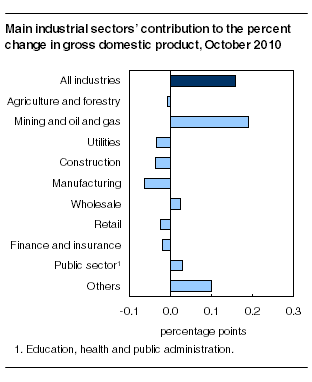Gross domestic product by industry
Archived Content
Information identified as archived is provided for reference, research or recordkeeping purposes. It is not subject to the Government of Canada Web Standards and has not been altered or updated since it was archived. Please "contact us" to request a format other than those available.
Related subjects
-
[an error occurred while processing this directive]
Real gross domestic product increased 0.2% in October following a 0.1% decline in September. Mining and oil and gas extraction was the main source of growth. Gains were also posted by real estate agents and brokers, the public sector, wholesale trade and transportation. Conversely, manufacturing, construction, utilities, retail trade as well as the finance and insurance sectors retreated.

Mining and oil and gas extraction increases
Mining and oil and gas extraction rose 2.4% in October. Oil and gas extraction advanced 1.3%, almost entirely on the strength of natural gas. Support activities for mining and oil and gas extraction rebounded (+9.9%) from its September decline, when unfavourable weather had hampered rigging activities. Pipeline transportation also increased.
Note to readers
The monthly gross domestic product (GDP) by industry data at basic prices are chained volume estimates with 2002 as their reference year. This means that the data for each industry and aggregate are obtained from a chained volume index multiplied by the industry's value added in 2002. For the 1997 to 2007 period, the monthly data are benchmarked to annually chained Fisher volume indexes of GDP obtained from the constant-price input-output tables.
For the period starting with January 2008, the data are derived by chaining a fixed-weight Laspeyres volume index to the prior period. The fixed weights are the industry output and input prices of 2007. This makes the monthly GDP by industry data more comparable with the expenditure-based GDP data, chained quarterly.
Revisions
With this release of monthly GDP by industry, revisions have been made back to January 2010. For more information about monthly GDP by industry, see the National Economic Accounts module on our website (www.statcan.gc.ca/nea-cen/index-eng.htm).
Output at copper, nickel, lead and zinc mines continued to recover following the end of labour disputes. Their output in October reached the levels recorded in the spring of 2009.

Manufacturing declines
Manufacturing decreased 0.6% in October, with manufacturers of non-durable goods cutting back production by 2.3% while those of durable goods increasing their output by 0.8%. Output at refineries was significantly reduced, partly due to extended maintenance. The manufacturing of pharmaceutical products as well as that of food and beverage products also declined. In contrast, manufacturers of motor vehicles and associated parts increased their production. On the whole, manufacturers reduced their inventories in October to help meet demand.
The home resale market up but construction down
An increase in the home resale market in several parts of the country led to a 5.1% rise in the output of real estate agents and brokers, marking a third consecutive monthly gain.
Construction declined 0.5% in October as residential building construction fell 1.7%. The construction of single dwellings as well as alterations and improvements led the drop. Non-residential building construction increased while engineering and repair work was unchanged.
Increase in wholesale trade but decline in retail
Wholesale trade grew 0.5% in October. This was mainly due to higher wholesaling activity of motor vehicles and parts, and personal and household goods. These gains were partly offset by reduced wholesaling of machinery and equipment.
Retail trade fell 0.4% after an increase of a similar magnitude in September. The decline in October was largely attributable to clothing stores and general merchandise stores (which include department stores). However, notable increases were reported by furniture, home furnishings and electronics stores.
The finance and insurance sector declines
The finance and insurance sector declined 0.3%, due to a reduced volume of trading on the stock exchanges and lower activities in the insurance sector. Banking activities were unchanged.

Available on CANSIM: table 379-0027.
Definitions, data sources and methods: survey number 1301.
The October 2010 issue of Gross Domestic Product by Industry, Vol. 24, no. 10 (15-001-X, free), is now available from the Key resource module of our website under Publications.
Data on gross domestic product by industry for November 2010 will be released on January 31, 2011.
For more information, or to order data, contact the dissemination agent (toll-free 1-800-887-4623; 613-951-4623; iad-info-dci@statcan.gc.ca). To enquire about the concepts, methods or data quality of this release, contact Bernard Lefrançois (613-951-3622), Industry Accounts Division.
- Date modified:
